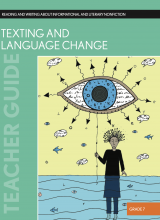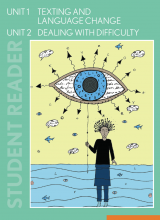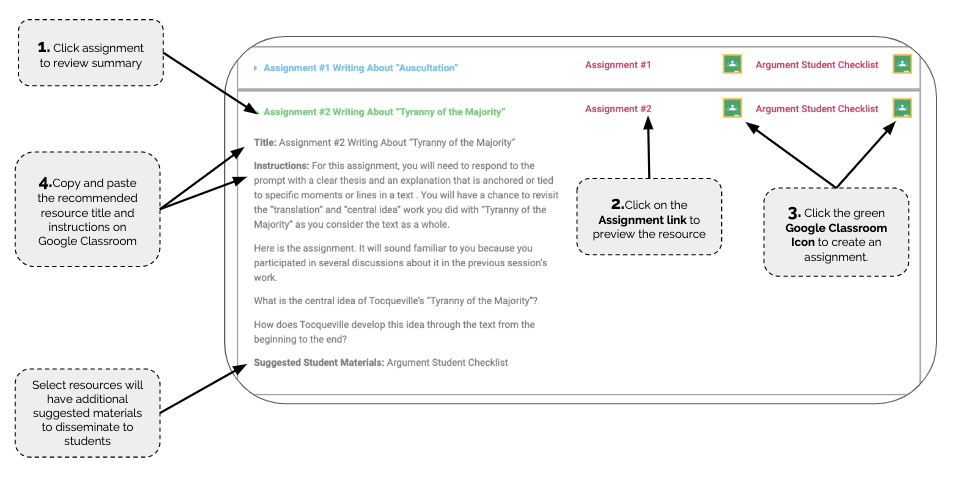Texting and Language Change - Grade 7
This study consists of two modules, each focused on a single informational text about texting and attitudes toward language change. Together these two short studies provide an introduction to the topic of texting and language change, and an orientation to the close reading of informational text. Through them, students are introduced to important ways of working with informational texts as well as to cycles of teaching and learning that feature significant amounts of reading, writing, and discussion.


Table of Contents
Writing Tasks
Title: “I h8 txt msgs”: Unfamiliar Terms and Confusing Moments
Teacher Manual Instructions:
Session 1-A
Next, tell students they will have a chance now to identify unfamiliar terms and moments that are difficult, confusing, or unclear.
Take a few minutes to introduce students to the four-column chart shown on the next page and ask them to use it as a template for their own list of unfamiliar terms or confusing moments. Although students will be work- ing together to create this list, each student should create and complete this four-column chart in her or his notebook.
Tell students that during this session’s work period they will be entering information in the first two columns only. They will add information to columns three and four later.
- The first column will indicate the line number in the text where the difficult, confusing, or unclear moment is located.
- The second column will consist of the unfamiliar terms and confusing moments students marked.
Give the groups 4-5 minutes to work on the first two columns of their chart. Use this time to circulate around the room and confer with groups about what they recorded.
Title: Small-Groups: Humphrys’ Claims About Texters and Texting
Teacher Manual Instructions:
Session 1-C
- Write the following question in a place that all students can see:
- What are Humphrys’ problems with texters and texting? In other words, what claims does he make about texters and texting? How do you know?
Ask students to take about 10 minutes to reread the article individually with the above question in mind. Tell students that as they read, they should mark moments that will help them answer the question. When they finish reading, they should make a list in their notebooks of Humphrys’ problems with texters and texting and the evidence or lines from the text to support what they identify.
As students are reading and composing their lists, circulate around the room to offer support and assistance as needed. Read students’ lists and evidence over their shoulders to get a sense of their responses. Be on the lookout for whether students are able to group or combine like items in order to generate a list of the major problems or claims.
Place students in trios. Have them take about 10 minutes to share their lists and evidence with each other, noting places of agreement and disagreement.
Then, ask students to work together to resolve their differences and create one shared list per trio of the claims that Humphrys makes about texters and texting. Their list should include evidence from the text to support each of the claims they identify. As trios are working, circulate around the room to confer with groups. If students have a long list, support them to group or combine like information into larger categories so that they have a list of the major claims.
Title: “2b or not 2b?”: Unfamiliar Terms and Confusing Moments
Teacher Manual Instructions:
Session 2-A
Next, tell students they will have a chance to identify unfamiliar terms and moments that are difficult, confusing, or unclear.
Have students return to their pair or trio groups. Take a few minutes to remind students of the four-column chart (see next page) that they used in Module 1 and ask them to use it again in this module as a template for their own list of unfamiliar terms or confusing moments. Although students will be working together, each student should create and complete this four-column chart in her or his notebook.
Tell students that during this session’s work period they will be entering information in the first two columns only. They will add information to columns three and four later.
The first column will indicate the line number where the difficult, confusing, or unclear moment is located.
The second column will consist of the unfamiliar terms and confusing moments students marked.
Give the groups 6-7 minutes to work on the first two columns of their chart. Use this time to circulate around the room and confer with groups about what they recorded.
Title: Small-Groups: Disproving Humphrys’ Claims
Teacher Manual Instructions:
Session 2-C
Place students in trios. Ask students to make a two-column chart in their notebooks. On the left side of the chart, students should list each of Humphrys’ claims. On the right side, students should list moments and evidence (with corresponding line numbers) from Crystal’s article that disprove Humphrys’ claims. As students are working on this task in their trio groups, circulate around the room to offer support and assistance as needed.
After students have worked for about 10-15 minutes, provide each trio with chart paper and markers. Ask each group to create a display chart of its work to share with the class. Post the charts on the board or a wall as the groups finish up their work.
Title: Writing Across Texts Texting and Language
Teacher Manual Instructions:
Session 2-D
Charts for Discussion
Title: What We Learned From Reading “I h8 txt msgs”
Teacher Manual Instructions:
Session 1-A
Facilitate a short, whole-group share where the class collaborates to create a master list of the same type of information. To create this master list, invite students to share what they learned from reading the text. Students should point to places in the text to support their responses. Capture student responses on a class chart titled “What We Learned From Reading ‘I h8 txt msgs.’”
As the class is working to create this master list, make sure students understand that this text represents Humphrys’ perspective on texting. In other words, this is his “take” on texting. Additionally, explain to students that since this is only their first read, and because they will be given multiple opportunities to reread this text, the intent is just to capture the gist of what they learned. It’s important to note that the pace of this “what we learned” activity is brisk and not at all comprehensive. Students will have opportunities to add to this master chart in the upcoming sessions.
Session 1-D
Closing Meeting
Convene another whole-group discussion in which students reflect on their work with “I h8 txt msgs” by responding to the questions below:
What did you learn about language change from reading this text? Using a different colored marker, jot down student responses on the “What We Learned From Reading ‘I h8 txt msgs’” chart.
Based on our work over the past few sessions, what can you say about what it means to engage in a close reading of informational texts?
Explain to students that the work they did with “I h8 txt msgs” was designed to introduce them to some basic and essential ways of close reading. Point out to students that the listing of what they learned from reading the text, the marking of unfamiliar terms and confusing moments, the search and study work to resolve those difficulties, and the careful thinking they did about what the text says and how the text works are key components of what is often referred to as “close reading.”
Point out that the ways of working that students experienced during this module (i.e., small- and large-group work, rereading, writing, and discussion) will remain an integral part of the work they will do with another article about texting and language change in the next module.
Title: Humphrys’ Claims About Texters and Texting
Teacher Manual Instructions:
Session 1-C
Convene a whole-group discussion in order to create a class chart of the claims that Humphrys makes about texters and texting. Title the chart “Humphrys’ Claims About Texters and Texting.”
As you create this class chart, work to capture Humphrys’ exact words, as they will be helpful in the next session when students study the tone of this piece.
Facilitate a whole-group discussion of whether Humphry’s claims are valid. During the discussion, press students to be specific about the reasons why they do or do not consider Humphrys’ claims valid. Additionally, encourage students to consider the reasons and evidence that Humphrys provides for his claims as opposed to simply considering whether they agree or disagree with Humphrys’ claims. Wrap up the discussion by asking students what, if anything, Humphrys could do to bolster the validity of his claims.
Title: What We Learned From Reading ‘2b or not 2b?
Teacher Manual Instructions:
Session 2-A
Convene the whole group to share what they learned. Students should cite places in the text to support their responses. Capture student responses on a class chart titled “What We Learned From Reading ‘2b or not 2b?’”
Tell students that since this is only their first read, and because they will be given multiple opportunities to reread this text, the intent here is just to capture the gist of what they learned. The pace of this “what we learned” activity should be brisk and not at all comprehensive. Give students a few extra minutes to record any additional insights from the master list into their own notebook.
Checks for Understanding
Title: “Leveraging the Human Brain’s Hunger for Story”: Unfamiliar Terms and Confusing Moments
Teacher Manual Instructions:
Session 1-A
Reconvene the class and facilitate a whole-group share where the class collaborates to complete the first two columns of a second master chart titled “‘I h8 txt msgs’: Unfamiliar Terms and Confusing Moments.”
To create this chart, call on students to share the unfamiliar terms and confusing moments from their group list. Capture these in column two of the class chart. Be sure to include line numbers for each term or moment in the first column.
Finally, ask students what questions they have after reading this text. These should be general questions that came up as a result of reading this article (e.g., “Who invented emoticons?”) as opposed to questions about unclear terms or confusing moments. Save these questions on a chart titled “Our Questions About Texting and Language Change” so that students can add to them or cross them off the list as they learn more about texting and language change. You might encourage students to look up answers at home and report back to the class in subsequent sessions.
Wrap up the work in this session by asking students to share the one or two things they learned from this text that they found most interesting or surprising.
Session 1-B:
Direct students’ attention to the class version of the “‘I h8 txt msgs’: Unfamiliar Terms and Confusing Moments” chart that they created during the closing meeting of Session 1-A. Add a third column header to this master list: How can we resolve this difficulty?
Revisit the list, item-by-item, and work with the class to generate ideas for the third column. These third column entries will support the search and study work students will do.
Wrap up the focus lesson by adding a heading for the fourth column: What did we learn from the search and study?
Closing Meeting
Once the small groups have completed their search and study work, reconvene the class and work as a group to share findings and negotiate entries to add to the fourth column: “What did we learn from the search and study?”
To do this, move one-by-one through the unfamiliar terms and confusing moments listed in column two of the master chart. Call on students to share their search and study findings. Be sure to “test” findings publicly by displaying a copy of the text for the class to see. Encourage other students to push back on errors or to make contributions that further develop or offer a more nuanced explanation for each entry. Consider using a timer to ensure that you’re spending no more than 90 seconds on each moment. During this time, students should be refining, correcting, or even adding new entries to their own chart in their notebook.
Wrap up the search and study work by asking students to reread the text again given their new insights, which have been entered in the “What did we learn?” column of the master chart.
Title: Our Questions About Texting and Language Change
Teacher Manual Instructions:
Session 1-A
Finally, ask students what questions they have after reading this text. These should be general questions that came up as a result of reading this article (e.g., “Who invented emoticons?”) as opposed to questions about unclear terms or confusing moments. Save these questions on a chart titled “Our Questions About Texting and Language Change” so that students can add to them or cross them off the list as they learn more about texting and language change. You might encourage students to look up answers at home and report back to the class in subsequent sessions.
Wrap up the work in this session by asking students to share the one or two things they learned from this text that they found most interesting or surprising.
Title: What We Learned About Identifying and Resolving Unfamiliar Terms or Difficult Moments
Teacher Manual Instructions:
Session 1-B
Finally, ask students to reflect on the search and study work with a discus- sion of the following two questions:
What more did you learn about this text from doing the search and study? Add relevant responses to the class version of the “I h8 txt msgs” chart.
What did you learn about working through unfamiliar terms and confusing moments from doing the search and study work? What did you do to tackle some of the most challenging moments? Capture responses on a new chart titled “What We Learned About Identifying and Resolving Unfamiliar Terms or Difficult Moments.”
Title: “2b or not 2b?”: Unfamiliar Terms and Confusing Moments
Teacher Manual Instructions:
Session 2-A
Reconvene the class and facilitate a whole-group share where the class collaborates to complete the first two columns of a class chart titled “‘2b or not 2b?’: Unfamiliar Terms and Confusing Moments.”
To create this master chart, call on students to share the unfamiliar terms and confusing moments from their group list. Capture these in column two of the class chart. Be sure to include line numbers for each term or moment in the first column. If students offer questions they have as a result of reading this text (e.g., “When is World Poetry Day?”) as opposed to terms or moments that are unfamiliar, confusing, or unclear, add those questions to the “Our Questions About Texting and Language Change” chart.
Wrap up the work in this session by asking students to share the one or two things they learned from this text that they found most interesting or surprising.
Independent Reading
Title: Reading Log
Teacher Manual Instructions:
Independent Reading
As you transition to independent reading, discuss how students can keep a reading log. Show students how you would like them to set up and use their reading log to record their independent reading this year. An example of one way a reading log could be set up is provided nearby. You may choose to have students create a table in their notebooks, use a pre-made sheet, or a digital format.
Explain to students that they should make an entry in their log only after they have finished a book. You will need to negotiate with students how to handle the entry of magazine readings (for example, entire issues versus individual articles).
After students have set up the log, including proper headings, creating the grid, etc., show students how to make an entry.
Answer any questions students have about the reading log.
Begin independent reading.
Consider conducting individual reading conferences with students as they are engaged in independent reading. In No More Independent Reading Without Support, Debbie Miller and Barbara Moss (2013) suggest that during early conferences, you should listen to students and work to build trust: Ask students how they view reading and how they think of themselves as readers; ask what they are interested in. Over time you can ask more about what they are reading and about how you can help them or what they are struggling with. Use what you learn from these conversations to guide additional instruction with groups or with the class.
Title: Independent Reading – Individual Planning Sheet
Instructions:
Title: End of Marking Period Self-Assessment
Instructions:
